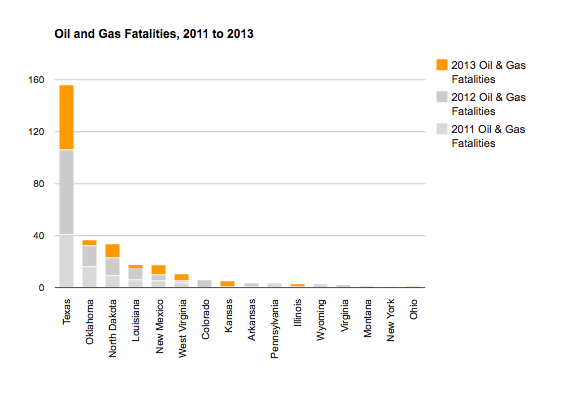In 2013, 11 oil and gas workers in North Dakota died from a job-related injury, according to data released by the Bureau of Labor Statistics.
Texas had 50 reported oil and gas worker fatalities in 2013, the most of any state. But Texas has roughly ten times more oil and gas workers than North Dakota.
Nationwide, 112 oil and gas workers died in 2013, down from 142 the year before.
The oil and gas industry, amid safety improvements, is still six times more dangerous than the average American job. And, as Inside Energy reported in our Dark Side Of The Boom series, oil and gas worker safety varies widely state by state. An oil and gas worker in North Dakota is three times more likely to die on the job than an oil and gas worker in Texas.
A single year of worker fatality data doesn’t tell us much about the industry’s safety record, so here’s a look at the past three years of data, state by state:
And here’s a table showing the data, from the BLS Census of Fatal Occupational Injuries, for oil and gas and the entire mining industry by state from 2011 through 2013:
To compare worker safety in a state with national safety standards, we need to know a fatality rate, or how many deaths occurred per 100,000 workers. Inside Energy calculated fatality rates for 2011 and 2012; you can read the results here and find out more about how we did it. We don’t yet have employee data for 2013, but when we do we’ll update the fatalities rates to include this new data.
The Bureau of Labor Statistics did not report any oil and gas fatalities in Colorado and Wyoming in 2013, but this does not mean no oil and gas workers died in these states. Each year, roughly 20 oil and gas worker fatalities that are included in the national statistics are not reported at the state level due to confidentiality issues. For example, Wyoming’s state occupational epidemiologist reported three oil and gas worker deaths in 2013, but none of these were included in the BLS count. Which means the fatal accident that happened in Wyoming this week might not be reflected in next year’s BLS fatality counts.
And in Colorado, while the BLS reports that four people died working in what they classify as “mining support” in 2013, we don’t know is whether or not they worked in oil and gas, or in some other kind of mining.
Data Notes:
- This data is provisional. BLS will publish updated workplace fatality data in 2015.
- Individual states often publish their own fatalities numbers, which may not match BLS figures due to differences in reporting and publishing practices.
- The oil and gas industry is defined by NAICS – a government classification system – codes 211, 213111 and 213112. Find out more about NAICS here.
- We got this data by accessing the BLS API. Want to use our code to do that? It’s on GitHub.








